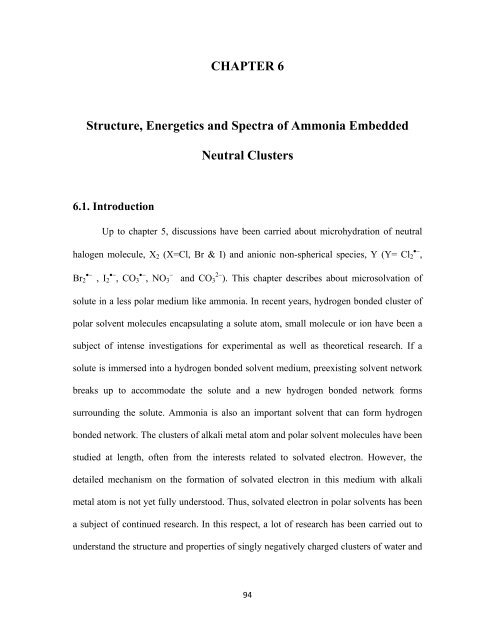CHEM01200604005 A. K. Pathak - Homi Bhabha National Institute
CHEM01200604005 A. K. Pathak - Homi Bhabha National Institute
CHEM01200604005 A. K. Pathak - Homi Bhabha National Institute
You also want an ePaper? Increase the reach of your titles
YUMPU automatically turns print PDFs into web optimized ePapers that Google loves.
CHAPTER 6<br />
Structure, Energetics and Spectra of Ammonia Embedded<br />
Neutral Clusters<br />
6.1. Introduction<br />
Up to chapter 5, discussions have been carried about microhydration of neutral<br />
halogen molecule, X 2 (X=Cl, Br & I) and anionic non-spherical species, Y (Y= Cl 2 •− ,<br />
Br 2 •− , I 2 •− , CO 3 •− , NO 3<br />
−<br />
and CO 3 2− ). This chapter describes about microsolvation of<br />
solute in a less polar medium like ammonia. In recent years, hydrogen bonded cluster of<br />
polar solvent molecules encapsulating a solute atom, small molecule or ion have been a<br />
subject of intense investigations for experimental as well as theoretical research. If a<br />
solute is immersed into a hydrogen bonded solvent medium, preexisting solvent network<br />
breaks up to accommodate the solute and a new hydrogen bonded network forms<br />
surrounding the solute. Ammonia is also an important solvent that can form hydrogen<br />
bonded network. The clusters of alkali metal atom and polar solvent molecules have been<br />
studied at length, often from the interests related to solvated electron. However, the<br />
detailed mechanism on the formation of solvated electron in this medium with alkali<br />
metal atom is not yet fully understood. Thus, solvated electron in polar solvents has been<br />
a subject of continued research. In this respect, a lot of research has been carried out to<br />
understand the structure and properties of singly negatively charged clusters of water and<br />
94
















